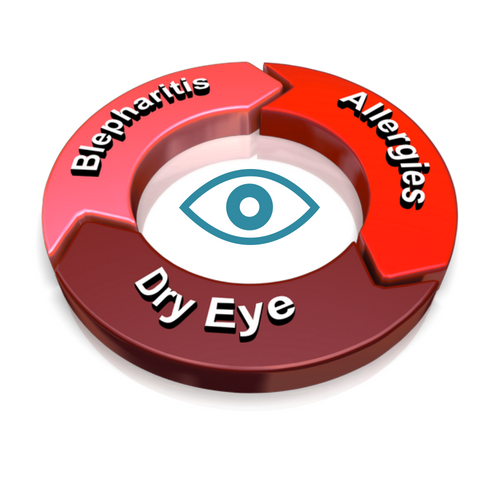Blepharitis, Dry Eye and Allergies
July 31, 2018

The three most common eye ailments that eye doctors see are dry eye syndrome, blepharitis, and eye allergies. These three conditions have similar symptoms - itchiness, redness, gritty sensation in the eyes, blurry vision, intolerance to contact lenses, and swollen eyelids. The symptoms are so similar that making a correct diagnosis and treatment is essential to attaining effective relief of your symptoms.
Blepharitis
Blepharitis is a result of inflammation of the eyelid leading to swelling. The affected eye can feel as though there is something in it, or it can be itchy with excessive tearing. The inflammation can be caused by an allergy, or a situation where the tiny oil glands near the base of the eye lashes simply get blocked. There are many possible causes of blepharitis.
Effective treatment depends on treating the underlying cause. If the cause is due to an allergy, by eliminating exposure to the allergen and using antihistamine eye drops the symptoms may resolve.
Eye Allergies
Eye allergies are an overreaction of your immune system to a substance. There are two types of eye allergies—seasonal and perennial. Seasonal allergies are triggered by substances in the air during specific seasons such as pollen from grass, trees, weeds, and spores. Perennial allergies are immune overreactions to substances found in the air year-round such as dust mites, perfumes, animal fur, smog, smoke, etc.
In either type of allergy, limiting your exposure is helpful such as wearing sunglasses to block contact to seasonal pollen and keeping windows closed, and in the case of year-round allergies to dust mites, frequent washing of bedding and floors can lessen exposure.
Antihistamine eye drops can alleviate the itchiness and redness. In severe cases your eye doctor may prescribe prescription eye drops. Systemic medications may be useful, too.
Dry Eye Syndrome
Dry eyes can be caused by a lack of tear film or tear film that evaporates too quickly. Your eye doctor can perform tests to determine the cause of your dry eyes and then determine the best treatment. Mild dry eye can be managed with the use of artificial tears. More severe cases can be treated with semi-permanent or dissolvable punctal plugs that prevent tears from draining away too quickly, or treatments to unblock meibomian glands. Prescription eye drops are useful.
LipiFlow is a new direct treatment for those who have dry eye due to meibomian gland dysfunction.
Overlap
Having one of these conditions can make you more susceptible to developing another one. For example, dry eyes don’t effectively wash away allergens and having blepharitis can affect your tear production.
If you have any of the symptoms common to dry eye, eye allergies, or blepharitis, make an appointment for a thorough eye exam and get started with a treatment plan designed specifically for you.
[/et_pb_text][et_pb_text _builder_version="3.3" global_module="2332"]
If you would like to make an appointment with Drs. Whitten or Rose, you may CALL US or USE OUR CONTACT FORM.



